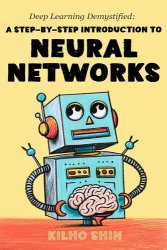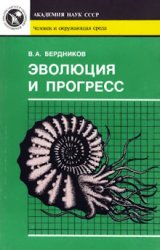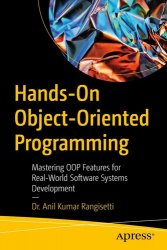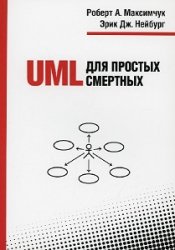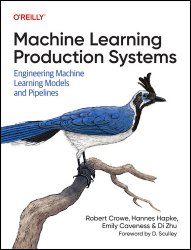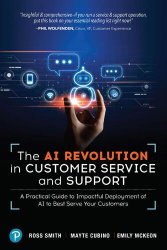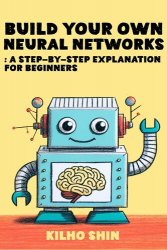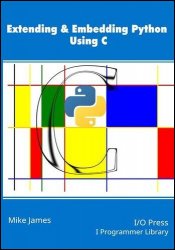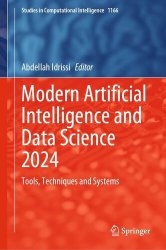 Название: Modern Artificial Intelligence and Data Science 2024: Tools, Techniques and Systems
Название: Modern Artificial Intelligence and Data Science 2024: Tools, Techniques and SystemsАвтор: Abdellah Idrissi
Издательство: Springer
Серия: Studies in Computational Intelligence
Год: 2024
Страниц: 591
Язык: английский
Формат: pdf (true)
Размер: 21.0 MB
This book, through its various chapters presenting recent advances in Modern Artificial Intelligence and Data Science as well as their applications, aims to set up lasting and real applications necessary for both academics and professionals.
By its proposals of new ideas, it serves as a real guide both to informed readers and to beginners in these specialized fields. It also covers applications that discuss how they can support societal challenges such as education, health, agriculture, clean energy, business, environment, and security.
The field of Data Science, for its part, has seen rapid growth in recent years, and thanks to the advances of AI, this growth has accelerated further. Artificial Intelligence and Data Science are two distinct fields, but they complement each other so well that their combination has become a powerful force for driving innovation and progress across all industries.
Data Science provides the tools and techniques necessary to ensure that the data used to train AI systems is reliable, accurate and free of bias. This is more than essential to develop reliable AI systems that can make fair and unbiased decisions. It provides the methods, techniques and tools needed to collect, store, clean and analyze data to identify patterns and extract insights.
Data Science thus focuses more on the study of knowledge extraction and data analysis using various scientific methods such as algorithms and processes. It is in fact a field that involves extracting information and knowledge from data. It involves various processes such as data collection, data visualization, data cleaning, data transformation and predictive modeling. Data Science can be used to solve various problems like detecting fraud, predicting customer behavior, recommending products to users and identifying disease outbreaks.
In Part I, entitled Artificial Intelligence, Machine Learning and Deep Learning, the reader will discover everything that revolves around Machine Learning and Deep Learning. Machine learning, which is a common component of AI and Data Science, encompasses the development of algorithms and systems capable of learning from data, making predictions and/or decisions based on this data and also improve over time.
Thanks to Machine Learning, AI algorithms can be trained on large data sets to recognize patterns, do classification, clustering and make predictions, allowing them to perform tasks such as text and voice recognition, object and image classification and natural language processing. This allows organizations to achieve better results, save time and gain insights into their data in real time, thereby improving their decision-making.
Deep Learning is a subset of machine learning. It uses artificial neural networks to simulate the functioning of the human brain and thus allowing making decisions that are more complex.
Part II, composed of ten chapters, is reserved to the theme of computer vision and NLP, which are other fields of AI that have many practical applications. Computer Vision allows using methods and algorithms to manage, analyze and interpret digital images and videos. One application of computer vision is text, facial and fingerprint recognition, which is used for privacy and security purposes. Another application is object recognition, which can be used to identify objects, images and videos. For example, self-driving cars use computer vision to detect pedestrians, obstacles and navigate roads. Computer vision involves the development of powerful algorithms that can manage, analyze and interpret visual data, such as images and videos. As for NLP, it involves the development of tools, methods and algorithms that can understand, manage and process human language.
Part III presents some applications of Artificial Intelligence in Education and eHealth sectors. In this framework, AI combined with Data Science can help enormously in these fields of education and health, as well as in any other field. Education seems to be the most important because everything starts there and from there. In the last 15 years, AI has made significant progress in education. Applications are now widely used by educators and learners, with variations between primary and university environments. In another hand, in the healthcare industry, the combination of Data Science and AI can be used to develop predictive models that can diagnose diseases and recommend treatment plans. The reader will find here ten chapters that deal with these sectors.
Part IV presents applications in the fields of IoT and security in general. Data privacy and security are critical concerns when combining AI and Data Science. This section includes Mapping Algorithms for Enhanced Autonomous Navigation, Enhancing Security in Edge Computing, Design of High-efficiency Power Amplifier using Nonlinear Device Modeling for IoT systems, Discovered Process-Aware IoT Models through Semantic Enrichment, Predicting Credit Risk of SMEs, Advanced Credit Card Fraud Detection, Malware classification in cloud computing using transfer learning and Multi-Agent Reinforcement Learning (MARL) for coordinating autonomous robots.
Finally, Part V includes methods revolving around services and some real-world problems, particularly in the context of automation or decision-making support. In this context, the readers will find in these ten chapters some studies on Optimization Strategies, Ontology Engineering, Data Quality Assessment, Supply Chain Management, Prediction of Railway Infrastructure Defects, Channel Allocation Problem, Wind Energy and Hydraulic Storage Systems and finally a survey about Learning-based Variable Speed Limit control strategies.
Readers will find here the fruit of many research ideas covering a wide range of application areas that can be explored for the advancement of their research or the development of their business. These ideas present new techniques and trends projected in various areas of daily life.
This book is therefore intended for Designers, Developers, Decision-Makers, Consultants, Engineers, and of course Master's/Doctorate Students, Researchers, and Universities.
Скачать Modern Artificial Intelligence and Data Science 2024: Tools, Techniques and Systems
[related-news] [/related-news]
Комментарии 0
Комментариев пока нет. Стань первым!
